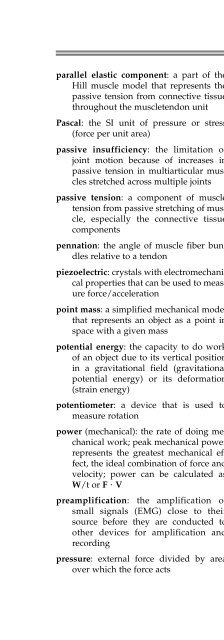Fundamentals of Biomechanics
Fundamentals of Biomechanics
Fundamentals of Biomechanics
Create successful ePaper yourself
Turn your PDF publications into a flip-book with our unique Google optimized e-Paper software.
parallel elastic component: a part <strong>of</strong> the<br />
Hill muscle model that represents the<br />
passive tension from connective tissue<br />
throughout the muscletendon unit<br />
Pascal: the SI unit <strong>of</strong> pressure or stress<br />
(force per unit area)<br />
passive insufficiency: the limitation <strong>of</strong><br />
joint motion because <strong>of</strong> increases in<br />
passive tension in multiarticular muscles<br />
stretched across multiple joints<br />
passive tension: a component <strong>of</strong> muscle<br />
tension from passive stretching <strong>of</strong> muscle,<br />
especially the connective tissue<br />
components<br />
pennation: the angle <strong>of</strong> muscle fiber bundles<br />
relative to a tendon<br />
piezoelectric: crystals with electromechanical<br />
properties that can be used to measure<br />
force/acceleration<br />
point mass: a simplified mechanical model<br />
that represents an object as a point in<br />
space with a given mass<br />
potential energy: the capacity to do work<br />
<strong>of</strong> an object due to its vertical position<br />
in a gravitational field (gravitational<br />
potential energy) or its deformation<br />
(strain energy)<br />
potentiometer: a device that is used to<br />
measure rotation<br />
power (mechanical): the rate <strong>of</strong> doing mechanical<br />
work; peak mechanical power<br />
represents the greatest mechanical effect,<br />
the ideal combination <strong>of</strong> force and<br />
velocity; power can be calculated as<br />
W/t or F • V<br />
preamplification: the amplification <strong>of</strong><br />
small signals (EMG) close to their<br />
source before they are conducted to<br />
other devices for amplification and<br />
recording<br />
pressure: external force divided by area<br />
over which the force acts<br />
APPENDIX A: GLOSSARY 291<br />
projectile: an object projected into space<br />
without self-propulsion capability, so<br />
the only forces acting on the object are<br />
gravity and air resistance<br />
proprioceptive neuromuscular facilitation<br />
(PNF): specialized stretching procedures<br />
that utilize sequences <strong>of</strong> muscle<br />
actions to potentiate reflexes to relax<br />
muscles being stretched<br />
prosthetics: artificial limbs<br />
Pythagorean Theorem: the two sides <strong>of</strong> a<br />
right triangle forming the right angle (a<br />
and b) and the hypotenuse (c) are related<br />
as follows: a2 + b2 = c2 qualitative analysis: systematic observation<br />
and introspective judgment <strong>of</strong> the<br />
quality <strong>of</strong> human movement for the<br />
purpose <strong>of</strong> providing the most appropriate<br />
intervention to improve performance<br />
(Knudson & Morrison, 2002)<br />
quantitative analysis: solving a biomechanical<br />
problem using numerical<br />
measurements and calculations<br />
quasistatic: the state <strong>of</strong> a mechanical system<br />
where the accelerations are small<br />
enough to be assumed equal to zero<br />
radian: a dimensionless unit <strong>of</strong> rotation<br />
equal to 57.3°<br />
radius <strong>of</strong> gyration: a convenient way to<br />
summarize an object's moment <strong>of</strong> inertia,<br />
defined as the distance from the axis<br />
<strong>of</strong> rotation at which half the object's<br />
mass must be placed in both directions<br />
to equal the object's moment <strong>of</strong> inertia<br />
range-<strong>of</strong>-motion principle: a biomechanical<br />
application principle which states<br />
that the amount <strong>of</strong> linear and angular<br />
motion used will affect the speed and<br />
accuracy <strong>of</strong> human movement






